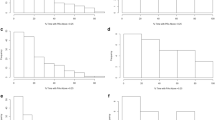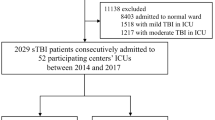Abstract
Objective
Detecting and treating elevated intracranial pressure (ICP) is a cornerstone of management in patients with severe traumatic brain injury. The aim of this study was to determine the association between area under the curve measurement of elevated ICP and clinical outcome.
Methods
Single center observational study using prospectively collected data at a University hospital, level one-trauma center. Sixty prospective patients with severe traumatic brain injury were prospectively enrolled over a 2-year period. Intracranial pressure measurements were captured using a real-time automated, high resolution vital signs data recording system. Mortality and functional outcome were assessed at 30 days, 3 and 6 months using Extended Glasgow Outcome Scale.
Results
Increasing elevated intracranial pressure time dose was associated with mortality (OR 1.08; 95 % confidence interval [CI], 1.01–1.15, p = 0.03) and poor functional outcome at 3 (OR 1.04; CI 1.00–1.07, p = 0.03) and 6 months (1.04; CI 1.01–1.08, p = 0.02). However, there was no association between episodic ICP data and outcome.
Conclusions
These results suggest that pressure time dose measurement of intracranial pressure may be used to predict outcome in severe traumatic brain injury and may be a candidate biomarker in this disease.

Similar content being viewed by others
References
Balestreri M, Czosnyka M, Hutchinson P, Steiner LA, Hiler M, Smielewski P, Pickard JD. Impact of intracranial pressure and cerebral perfusion pressure on severe disability and mortality after head injury. Neurocrit Care. 2006;4(1):8–13.
Carter BG, Butt W, Taylor A. ICP and CPP: excellent predictors of long term outcome in severely brain injured children. Childs Nerv Syst. 2008;24(2):245–51.
Juul N, Morris GF, Marshall SB, Marshall LF. Intracranial hypertension and cerebral perfusion pressure: influence on neurological deterioration and outcome in severe head injury. The executive committee of the international selfotel trial. J Neurosurg. 2000;92(1):1–6.
Brain Trauma Foundation, American Association of Neurological Surgeons, Congress of Neurological Surgeons, Joint Section on Neurotrauma and Critical Care, AANS/CNS, Bratton SL, Chestnut RM, Ghajar J, McConnell Hammond FF, Harris OA, Hartl R, Manley GT, Nemecek A, Newell DW, Rosenthal G, Schouten J, Shutter L, Timmons SD, Ullman JS, Videtta W, Wilberger JE, Wright DW. Guidelines for the management of severe traumatic brain injury. VI. Indications for intracranial pressure monitoring. J Neurotrauma. 2007;24(Suppl 1):S37–44.
Cooper DJ, Rosenfeld JV, Murray L, Arabi YM, Davies AR, D’Urso P, Kossmann T, Ponsford J, Seppelt I, Reilly P, Wolfe R, DECRA Trial Investigators, Australian and New Zealand Intensive Care Society Clinical Trials Group. Decompressive craniectomy in diffuse traumatic brain injury. N Engl J Med. 2011;364(16):1493–502.
Servadei F. Clinical value of decompressive craniectomy. N Engl J Med. 2011;364(16):1558–9.
Sorani MD, Hemphill JC 3rd, Morabito D, Rosenthal G, Manley GT. New approaches to physiological informatics in neurocritical care. Neurocrit Care. 2007;7(1):45–52.
Kahraman S, Dutton RP, Hu P, Xiao Y, Aarabi B, Stein DM, Scalea TM. Automated measurement of “pressure times time dose” of intracranial hypertension best predicts outcome after severe traumatic brain injury. J Trauma. 2010;69(1):110–8.
Venkatesh B, Garrett P, Fraenkel DJ, Purdie D. Indices to quantify changes in intracranial and cerebral perfusion pressure by assessing agreement between hourly and semi-continuous recordings. Intensive Care Med. 2004;30(3):510–3.
Wijman CA, Smirnakis SM, Vespa P, Szigeti K, Ziai WC, Ning MM, Rosand J, Hanley DF, Geocadin R, Hall C, Le Roux PD, Suarez JI, Zaidat OO, First Neurocritical Care Research Conference Investigators. Research and technology in neurocritical care. Neurocrit Care. 2012;16(1):42–54.
Vik A, Nag T, Fredriksli OA, Skandsen T, Moen KG, Schirmer-Mikalsen K, Manley GT. Relationship of “dose” of intracranial hypertension to outcome in severe traumatic brain injury. J Neurosurg. 2008;109(4):678–84.
Barton CW, Hemphill JC 3rd. Cumulative dose of hypertension predicts outcome in intracranial hemorrhage better than American heart association guidelines. Acad Emerg Med. 2007;14(8):695–701.
Barton CW, Hemphill JC, Morabito D, Manley G. A novel method of evaluating the impact of secondary brain insults on functional outcomes in traumatic brain-injured patients. Acad Emerg Med. 2005;12(1):1–6.
Marshall LF, Marshall SB, Klauber MR, Van Berkum Clark M, Eisenberg H, Jane JA, Luerssen TG, Marmarou A, Foulkes MA. The diagnosis of head injury requires a classification based on computed axial tomography. J Neurotrauma. 1992;9(Suppl 1):S287–92.
Wilson JT, Pettigrew LE, Teasdale GM. Structured interviews for the Glasgow Outcome Scale and the extended Glasgow Outcome Scale: guidelines for their use. J Neurotrauma. 1998;15(8):573–85.
Hemphill JC 3rd, Barton CW, Morabito D, Manley GT. Influence of data resolution and interpolation method on assessment of secondary brain insults in neurocritical care. Physiol Meas. 2005;26(4):373–86.
Brain Trauma Foundation, Brain Trauma Foundation, American Association of Neurological Surgeons, Congress of Neurological Surgeons, Joint Section on Neurotrauma and Critical Care, AANS/CNS, Bratton SL, Chestnut RM, Ghajar J, McConnell Hammond FF, Harris OA, Hartl R, Manley GT, Nemecek A, Newell DW, Rosenthal G, Schouten J, Shutter L, Timmons SD, Ullman JS, Videtta W, Wilberger JE, Wright DW. Guidelines for the management of severe traumatic brain injury. IX. Cerebral perfusion thresholds. J Neurotrauma. 2007;24(Suppl 1):S59–64.
Brain Trauma Foundation, Brain Trauma Foundation, American Association of Neurological Surgeons, Congress of Neurological Surgeons, Joint Section on Neurotrauma and Critical Care, AANS/CNS, Bratton SL, Chestnut RM, Ghajar J, McConnell Hammond FF, Harris OA, Hartl R, Manley GT, Nemecek A, Newell DW, Rosenthal G, Schouten J, Shutter L, Timmons SD, Ullman JS, Videtta W, Wilberger JE, Wright DW. Guidelines for the management of severe traumatic brain injury. VIII. Intracranial pressure thresholds. J Neurotrauma. 2007;24(Suppl 1):S55–8.
Cremer OL, van Dijk GW, van Wensen E, Brekelmans GJ, Moons KG, Leenen LP, Kalkman CJ. Effect of intracranial pressure monitoring and targeted intensive care on functional outcome after severe head injury. Crit Care Med. 2005;33(10):2207–13.
Elf K, Nilsson P, Ronne-Engstrom E, Howells T, Enblad P. Cerebral perfusion pressure between 50 and 60 mmHg may be beneficial in head-injured patients: a computerized secondary insult monitoring study. Neurosurgery. 2005;56(5):962–71. discussion 962–71.
Bulger EM, Nathens AB, Rivara FP, Moore M, MacKenzie EJ, Jurkovich GJ, Brain Trauma Foundation. Management of severe head injury: institutional variations in care and effect on outcome. Crit Care Med. 2002;30(8):1870–6.
Weaver DD, Winn HR, Jane JA. Differential intracranial pressure in patients with unilateral mass lesions. J Neurosurg. 1982;56(5):660–5.
O’Phelan KH, Park D, Efird JT, Johnson K, Albano M, Beniga J, Green DM, Chang CW. Patterns of increased intracranial pressure after severe traumatic brain injury. Neurocrit Care. 2009;10(3):280–6.
Murray GD, Butcher I, McHugh GS, Lu J, Mushkudiani NA, Maas AI, Marmarou A, Steyerberg EW. Multivariable prognostic analysis in traumatic brain injury: results from the IMPACT study. J Neurotrauma. 2007;24(2):329–37.
Stein DM, Hu PF, Brenner M, Sheth KN, Liu KH, Xiong W, Aarabi B, Scalea TM. Brief episodes of intracranial hypertension and cerebral hypoperfusion are associated with poor functional outcome after severe traumatic brain injury. J Trauma. 2011;71(2):364–73. discussion 373–4.
Acknowledgments
Funding support was provided through American Academy of Neurology Clinical Research Award (KNS).
Author information
Authors and Affiliations
Corresponding author
Rights and permissions
About this article
Cite this article
Sheth, K.N., Stein, D.M., Aarabi, B. et al. Intracranial Pressure Dose and Outcome in Traumatic Brain Injury. Neurocrit Care 18, 26–32 (2013). https://doi.org/10.1007/s12028-012-9780-3
Published:
Issue Date:
DOI: https://doi.org/10.1007/s12028-012-9780-3




